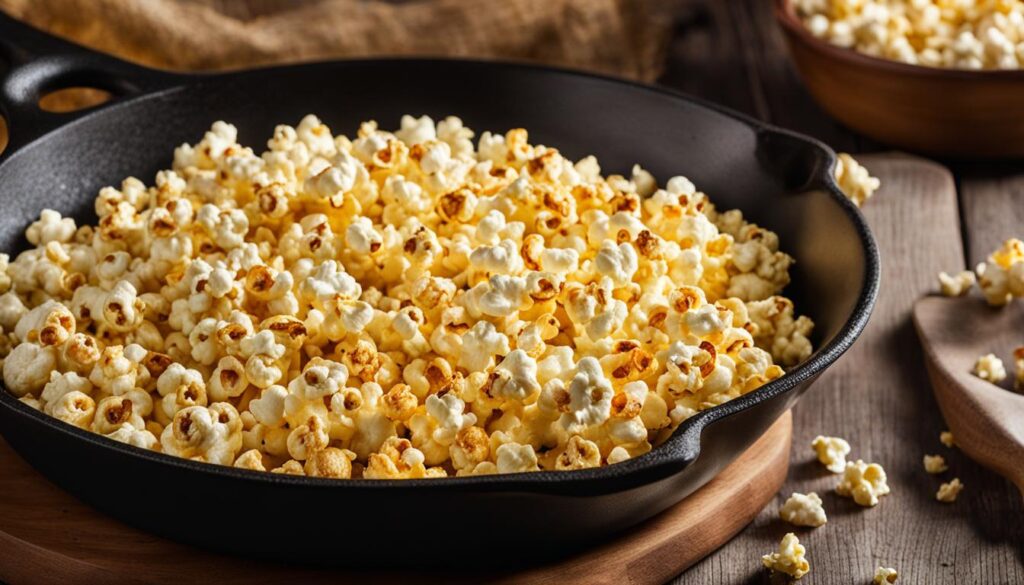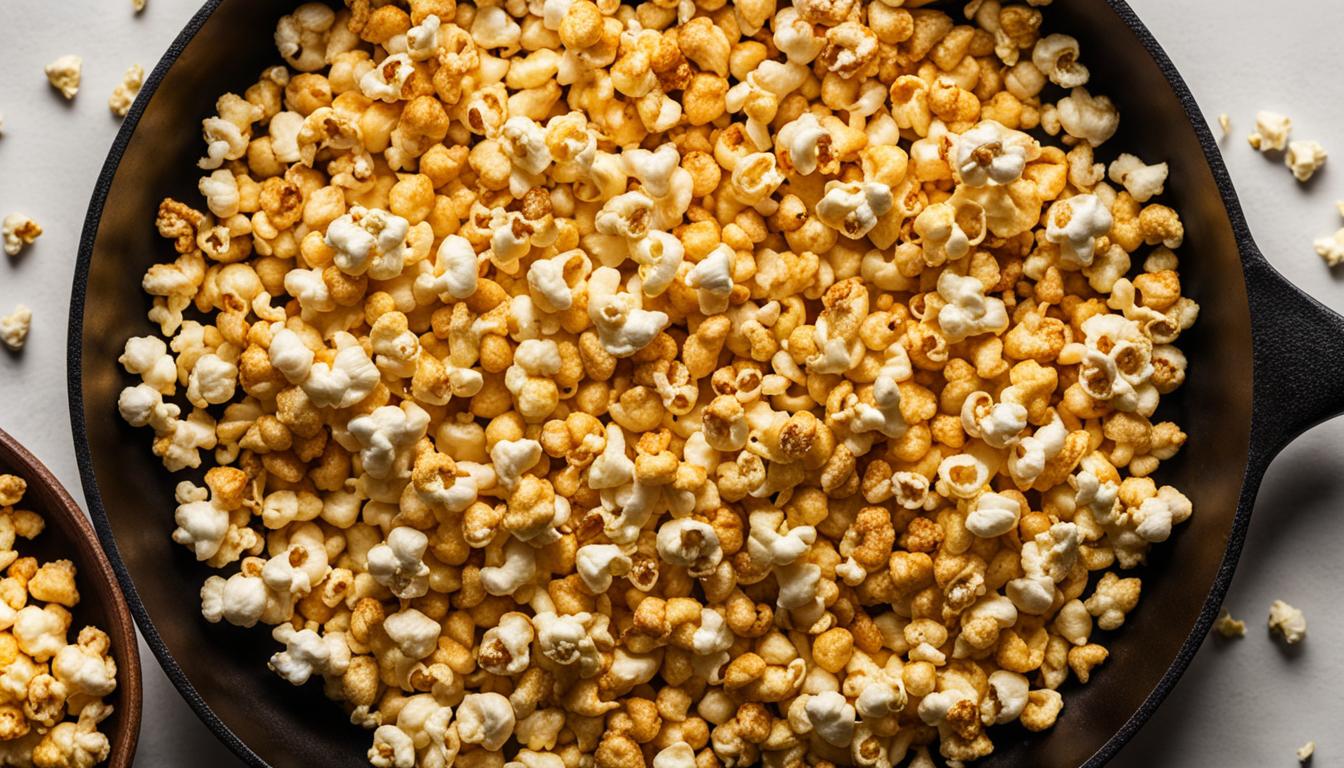Popcorn is a beloved snack that can be enjoyed in various ways. While many people opt for the convenience of microwave popcorn or popcorn machines, there is another method that is equally delicious and easy: making popcorn in a skillet.
Yes, you read that right! You can make popcorn in a skillet, and it’s a game-changer. Not only is it a fun and interactive way to create your own popcorn masterpiece, but it also allows for customization and control over the ingredients.
So, how do you make popcorn in a skillet? It’s simpler than you might think. All you need are popcorn kernels, a good skillet with a lid, oil, and salt. With these basic ingredients, you can whip up a batch of deliciously fluffy popcorn in under 10 minutes.
Making popcorn in a skillet not only offers a tasty alternative to microwave popcorn and pre-packaged options, but it also provides several benefits. You can choose high-quality oils, avoid artificial preservatives, and customize your flavors to suit your preferences.
Key Takeaways:
- Making popcorn in a skillet is a simple and delicious alternative to microwave popcorn.
- You only need popcorn kernels, a skillet with a lid, oil, and salt to make stovetop popcorn.
- Skillet popcorn allows for customization and control over ingredients, resulting in flavorful and fluffy popcorn.
- Making popcorn in a skillet is a healthier and cost-effective option compared to pre-packaged popcorn.
- Using high-quality oils and avoiding excessive butter and unhealthy toppings can make skillet popcorn a nutritious snack choice.
How to Make Popcorn in a Skillet: Tips and Techniques
When it comes to making popcorn in a skillet, there are a few key tips and techniques to keep in mind for the best results. Here’s our step-by-step guide:
1. Choose a Good Skillet
Start by selecting a good, heavy-bottomed skillet that distributes heat evenly. This will help ensure that your popcorn pops uniformly and doesn’t burn.
2. Heat the Skillet and Oil
Next, heat the skillet over medium heat and add your desired popcorn oil. It’s important not to crank the heat up too high, as this can lead to burned oil and popcorn. Instead, a medium heat setting will allow the kernels to pop without scorching.
3. Test the Oil Temperature
To test the oil temperature, add two popcorn kernels to the skillet and cover it with a lid. Once these kernels pop, it’s a sign that the oil is hot enough for the rest of the popcorn. At this point, you can add the remaining kernels.
4. Prime the Popcorn
Once all the popcorn kernels are in the skillet, remove it from the heat for about a minute. This “priming” step allows the popcorn to evenly distribute heat before the popping starts.
5. Tilt the Lid and Monitor
As the popcorn begins to pop, tilt the lid slightly to release steam and prevent the popcorn from becoming soggy. It’s important to monitor the popping process closely to avoid burning the popcorn or letting it overflow the skillet.
- If the popcorn starts to overflow, remove the lid and transfer the excess popcorn to a bowl before continuing to cook.
- Remember to give the skillet a gentle shake every now and then to prevent any kernels from sticking to the bottom.
6. Season and Enjoy
Once the popping slows down significantly, remove the skillet from the heat and let it sit for a minute to allow any remaining popcorn to finish popping. Then, carefully remove the lid, season your popcorn with salt or any other desired toppings, and gently toss to distribute the flavors.
Now, your delicious homemade popcorn is ready to be enjoyed while watching your favorite movie or simply as a satisfying snack!
Benefits of Making Skillet Popcorn

When it comes to making popcorn, using a skillet offers a range of benefits that make it a popular choice among popcorn enthusiasts. Not only is it a healthier option compared to microwave popcorn, but it also allows for customization and cost savings.
First and foremost, making popcorn in a skillet gives you complete control over the ingredients. You can choose high-quality oils, such as extra-virgin olive oil or coconut oil, which add nutritional value and healthy fats to your snack. Unlike pre-packaged microwave popcorn, skillet popcorn doesn’t contain artificial preservatives or chemicals. This means you can enjoy a wholesome and natural treat.
Another advantage of making skillet popcorn is the cost-effectiveness. Buying pre-bagged popcorn can be quite expensive, especially if you’re a popcorn lover. By using popcorn kernels and a skillet, you can make a large batch of popcorn at a fraction of the cost. It’s a budget-friendly option that allows you to enjoy a flavorful and satisfying snack without breaking the bank.
Customization is key
Skillet popcorn also offers endless possibilities for customization. You can experiment with different oils, seasonings, and toppings to create unique flavor combinations. Whether you prefer a classic butter and salt flavor or want to explore more adventurous options like caramel or spicy cheese, the choice is yours. The versatility of skillet popcorn allows you to tailor the snack to your personal taste preferences.
So why settle for store-bought popcorn when you can enjoy the deliciousness of homemade skillet popcorn? Not only does it give you total control over the ingredients and flavors, but it also saves you money in the long run. Get creative with your seasonings, gather your favorite movie snacks, and elevate your movie nights with a bowl of piping hot skillet popcorn!
Benefits of Making Skillet Popcorn:
- Healthier alternative to microwave popcorn
- Control over ingredients
- Cost-effective
- Endless customization options
The Health Benefits of Skillet Popcorn

Making popcorn in a skillet can be a healthier snack option, providing a range of health benefits when prepared with the right ingredients. Firstly, using high-quality oils, such as extra-virgin olive oil or coconut oil, adds nutritional value to the popcorn. These oils are rich in healthy fats, which are essential for a balanced diet.
Moreover, popcorn itself is a whole grain, making it a nutritious choice. Whole grains contain fiber, which aids in digestion and helps maintain a healthy weight. Additionally, fiber promotes heart health by reducing cholesterol levels and improving overall cardiovascular function.
To enjoy the health benefits of skillet popcorn to the fullest, it is important to avoid excessive butter or unhealthy toppings. Instead, opt for seasonings like herbs, spices, or grated cheese to add flavor without compromising nutritional value. By making mindful choices, you can savor a guilt-free and nourishing snack.
The Benefits of Skillet Popcorn with High-Quality Oils:
- Provides essential healthy fats
- Enhances nutritional value
- Supports a balanced diet
The Advantages of Whole Grain Popcorn:
- Offers fiber for improved digestion
- Aids in maintaining a healthy weight
- Promotes heart health
Conclusion
Making popcorn in a skillet is a convenient and budget-friendly way to enjoy delicious and customizable popcorn at home. We’ve learned that stovetop popcorn is not only simple to make but also yields flavorful and fluffy results in under 10 minutes. By following a few tips and techniques, such as using a good skillet, controlling the heat, and seasoning carefully, you can achieve perfectly popped popcorn every time.
Skillet popcorn offers a healthier alternative to microwave popcorn. It allows us to avoid artificial preservatives and chemicals commonly found in pre-packaged options. Plus, using high-quality oils and toppings adds nutritional value and personalizes the flavor experience. It’s a win-win situation!
So, if you’re wondering, “Can you pop popcorn in a skillet?” the answer is a resounding yes! The skillet popcorn method is not only fun and easy but also allows for creative flavor variations. Whether you’re having a movie night or simply craving a tasty snack, grab your skillet, some popcorn kernels, and get ready to enjoy the deliciousness of homemade skillet popcorn. Happy popping!
FAQ
Can you pop popcorn in a skillet?
Yes, you can make delicious popcorn in a skillet! It’s a simple and tasty alternative to using a popcorn machine or microwave.
What do I need to make popcorn in a skillet?
To make popcorn in a skillet, you will need popcorn kernels, a good skillet with a lid, oil, and salt.
How long does it take to make popcorn in a skillet?
Making popcorn in a skillet takes under 10 minutes. It’s a quick and easy snack!
How do I prevent the popcorn from burning?
It’s important to use a good, heavy-bottomed skillet that distributes heat evenly. Avoid cranking the heat up too high to prevent burning the oil.
Can I customize the flavor of the popcorn?
Absolutely! Making popcorn in a skillet allows for customization and control over the ingredients. You can season it with salt or add any additional toppings or flavors you desire.
Is skillet popcorn a healthier option?
Skillet popcorn can be a healthier alternative to microwave popcorn. It allows for the use of high-quality oils and avoids artificial preservatives and chemicals commonly found in pre-packaged popcorn.
What are the benefits of making skillet popcorn?
Making skillet popcorn is cost-effective, as it is significantly cheaper than buying pre-bagged popcorn. It also offers more customization options, allowing for the use of different oils, seasonings, and toppings.
Is skillet popcorn a nutritious snack?
When made with the right ingredients, skillet popcorn can be a healthier snack option. Using high-quality oils adds nutritional value, and popcorn itself is a whole grain that offers fiber.
How can I achieve perfectly popped popcorn in a skillet?
By using a heavy-bottomed skillet, controlling the heat, and seasoning carefully, you can achieve perfectly popped popcorn in a skillet.

Leave a Reply